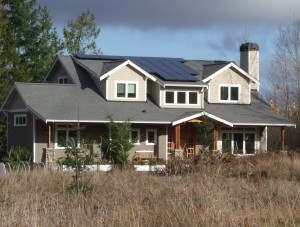 “Do you install batteries with the Solar Panels?”
“Do you install batteries with the Solar Panels?”
Recommendation #1 – If possible, build your home and structure your life so that a few days without electricity is not an emergency. This means:
- Secondary heat source if primary source of heat for house is electric.
- Keep some water stored in containers if you have a well pump and no tanked storage (this is a good idea even if you rely on a municipal water system.)
- Plenty of rechargeable batteries for flashlights and radios.
- Portable stove for cooking if you have an electric stove in your kitchen.
- Heat water for washing dishes and hands and face on wood stove or cook stove if you have an electric water heater.
- Eat the food that will spoil first, consolidate in freezer. If temp is freezing outside, this can help keep some food frozen. It may also be possible for you to get ice from a store to keep fridge and freezer cold.
- A small portable inverter that can charge your mobile devices from the car battery. This can be very small that plugs into your car “cigarette lighter” port, or slightly larger that will clamp onto your car battery terminals.
This is the advice that will let you get through ordinary outages with minimal inconvenience for the least expenditure.
Recommendation #2 – If recommendation #1 does not work for you, buy a generator that uses fuel you are already using for other engines. If you have a car that runs on gasoline, get a small gas generator and store some gas. In the order of expense and capacity from lowest to highest:
- A small generator and a heavy duty extension cord with a surge strip can power several plug-in devices. A Honda 2000 watt generator is less than $1000 and is very quiet while sipping gasoline.
- Re-wire a small number of “critical circuits” into a backed up sub-panel, and use a generator transfer switch to manually disconnect from grid, and run those circuits from a small generator.
- Get a large whole-house generator, and replace your main service panel with an auto-transfer panel.
Here are the reasons we do not currently offer battery back-up:
- Batteries are currently expensive, inefficient, and relatively low energy density on a residential scale. It is possible you could spend tens of thousands of dollars on a huge battery back-up, and still be out of power three days into a winter outage.
- The best practice for combining batteries and pv is to utilize an AC-coupled battery system. Our homes run using AC electricity (alternating current.) Previously, battery back-up systems were DC-based systems where the pv power source had been connected directly to batteries before being converted to AC by inverter for use in the house.
- With an AC-coupled system, the pv power is sent directly to the a grid-tied inverter and the power is either used by house loads or sent back onto grid. The battery bank is managed by its own inverter/charger and is just another household appliance.
- The AC coupled battery system can be added at any time to a house with a grid-tied pv system.
Recommendation #3 – You should install the grid-tied pv system without batteries now because:
- Prices are lower than ever.
- All of the available incentives from federal to state are focusing on grid-tied pv systems, and there are no incentives for battery back-up systems.
- An AC-coupled battery system can be added later, hopefully after prices fall and perhaps better battery technologies will be available as a result of the growth of the Electric Vehicle market.
If you are inclined to do further research on your own, here are three AC-coupled systems we are currently keeping an eye on, with the intention of installing for our existing solar customers when the technology and pricing improves.